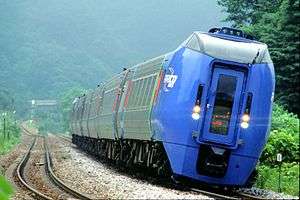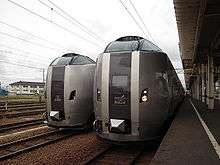Hokkaido Railway Company
.svg.png) | |
Native name | 北海道旅客鉄道株式会社 |
|---|---|
| Corporation | |
| Industry | Private railway |
| Predecessor | Japanese National Railways (JNR) |
| Founded | April 1, 1987 (privatization of JNR) |
| Headquarters | Chūō-ku, Sapporo, Hokkaido, Japan |
Area served | Hokkaido |
| Products | Kitaca (a rechargeable contactless smart card) |
| Services |
Passenger rail Freight services Intercity bus |
| Owner | Japan Railway Construction, Transport and Technology Agency (100%) |
Number of employees | 7,970 (as of April 1, 2007) |
| Subsidiaries | JR Hokkaido Bus |
| Website |
www2 |
The Hokkaido Railway Company (北海道旅客鉄道株式会社 Hokkaidō Ryokaku Tetsudō Kabushiki-gaisha) is one of the constituent companies of Japan Railways Group (JR Group), and is often referred to using its official abbreviation of JR Hokkaido (JR北海道 Jeiāru Hokkaidō). It operates intercity rail services in Hokkaido, Japan. The company introduced Kitaca, a smart card ticketing system, from autumn 2008.
At the time of its privatization in 1987, JR Hokkaido operated 21 railway lines totalling 3,176.6 kilometres (1,973.8 mi) of narrow-gauge (1,067 mm (3 ft 6 in)) track, as well as a ferry service to Aomori. Since then, that number has dwindled to just below 2,500 kilometres (1,600 mi), as unprofitable lines have been shut down or spun off (in the case of the Hokkaidō Chihoku Kōgen Railway). The ferry service has also been replaced by the Seikan Tunnel.
On 19 November 2016, JR Hokkaido's President announced plans to further rationalise its network by up to 1,237 km, or ~50% of the current network,[1] including closure of the entire Rumoi Main Line (the Rumoi - Mashike section is already confirmed to close on 4 December 2016), the Shin-Yubari - Yubari section of the Sekisho Line, the non-electrified section of the Sassho Line and the Nemuro Line between Furano and Kami-Ochiai Junction. Other lines including the Sekihoku Main Line, Senmo Main Line, the Naroyo - Wakkanai section of the Soya Line and Kushiro - Nemuro section of the Nemuro Line are proposed for conversion to Third Sector operation, but if local governments are not agreeable, such sections will also face closure.
Hokkaido Railway's headquarters are in Chūō-ku, Sapporo.[2]
History
- April 1, 1987: Upon the privatization of the Japanese National Railways (JNR), the Hokkaido Railway Company was formed
- October 25, 2008: Kitaca contactless smart card introduced in Sapporo area
- March 26, 2016: First Hokkaido Shinkansen service between Shin-Aomori and Shin-Hakodate-Hokuto launched.
Headquarters and branch offices
- Headquarters: 1-1-15 Kita-11-jō-Nishi, Chūō-ku, Sapporo
- Branch offices:
Lines and key stations


Shinkansen
- Hokkaido Shinkansen:
- Shin-Aomori - Shin-Hakodate-Hokuto (148.9 km (92.52 mi))
Trunk lines
- Chitose Line:
- Shiroishi - Numanohata (60.2 km (37.41 mi))
- Minami-Chitose - New Chitose Airport (2.6 km (1.62 mi))
- Hakodate Main Line([* 1])
- Hakodate - Ōnuma-Kōen - Otaru - Sapporo - Asahikawa (423.1 km (262.90 mi))
- Nanae - Oshima-Sawara - Mori (35.3 km (21.93 mi))
- Muroran Main Line
- Oshamanbe - Higashi-Muroran - Oiwake - Iwamizawa (211.0 km (131.11 mi))
- Higashi-Muroran - Muroran (7.0 km (4.35 mi))
- Nemuro Main Line
- Sekishō Line
- Minami-Chitose - Shintoku (132.4 km (82.27 mi))
- Shin-Yūbari - Yūbari (16.1 km (10.00 mi))
- ↑ Most trains run between Sapporo and Oshamanbe.
Other lines
- Furano Line
- Furano - Asahikawa (54.8 km (34.05 mi))
- Hidaka Main Line
- Sekihoku Main Line
- Shin-Asahikawa - Kitami - Abashiri (234.0 km (145.40 mi))
- Kaikyō Line
- Naka-Oguni - Tsugaru-Imabetsu - Kikonai (87.3 km (54.25 mi))
- Rumoi Main Line
- Sasshō Line
- Sōen - Shin-Totsukawa (76.5 km (47.53 mi))
- Senmō Main Line
- Higashi-Kushiro - Abashiri (166.2 km (103.27 mi))
- Sōya Main Line
Under construction
- Hokkaido Shinkansen
- Shin-Hakodate-Hokuto - Sapporo (211.3 km (131.30 mi)) scheduled to open in 2031
Former lines
- Chihoku Line
- Ikeda - Kitami (140.0 km (86.99 mi)) transferred to Hokkaidō Chihoku Kōgen Railway Company on June 4, 1989
- Esashi Line
- Goryōkaku - Kikonai (37.8 km (23.49 mi)) transferred to South Hokkaido Railway Company on March 26, 2016
- Kikonai - Esashi (42.1 km (26.16 mi)) closed on May 12, 2014
- Hakodate Main Line branch
- Sunagawa - Kami-Sunagawa (7.3 km (4.54 mi)) closed on May 16, 1994
- Horonai Line
- Iwamizawa - Ikushumbetsu (18.1 km (11.25 mi)) and Mikasa - Horonai (2.7 km (1.68 mi)) closed on July 13, 1987
- Matsumae Line
- Kikonai - Matsumae (50.8 km (31.57 mi)) closed on February 1, 1988
- Nayoro Main Line
- Shibetsu Line
- Shimmei Line
- Tempoku Line
- Otoineppu - Minami-Wakkanai (148.9 km (92.52 mi)) closed on May 1, 1989
- Utashinai Line
- Sunagawa - Utashinai (14.5 km (9.01 mi)) closed on April 25, 1988
The company also operated the Seikan Ferry until 1988.
Former JNR lines closed before JR Hokkaido formation
These lines have been closed by JNR in Hokkaido before April 1, 1987.
- Aioi Line
- Bihoro - Kitami-Aioi (36.8 km (22.87 mi)) closed on April 1, 1985
- Bikō Line
- Bifuka - Niupu (21.2 km (13.17 mi)) closed on September 17, 1985
- Haboro Line
- Hiroo Line
- Iburi Line
- Kutchan - Datemombetsu (83.0 km (51.57 mi)) and Kyōgoku - Wakikata (7.5 km (4.66 mi)) closed on November 11, 1986
- Iwanai Line
- Kozawa - Iwanai (14.9 km (9.26 mi)) closed on September 1, 1985
- Kōhin'hoku Line
- Hama-Tombetsu - Kitami-Esashi (30.4 km (18.89 mi)) closed on September 1, 1985
- Kōhin'nan Line
- Ōmu - Okoppe (19.9 km (12.37 mi)) closed on September 15, 1985
- Konpoku Line
- Shiretoko-Shari - Koshikawa (12.8 km (7.95 mi)) closed on December 1, 1970
- Manji Line
- Shibun - Manji-Tanzan (23.8 km (14.79 mi)) closed on April 1, 1985
- Setana Line
- Kunnui - Setana (48.4 km (30.07 mi)) closed on March 16, 1987
- Shihoro Line
- Obihiro - Tokachi-Mitsumata (78.3 km (48.65 mi)) closed on March 23, 1987
- Shiranuka Line
- Shiranuka - Hokushin (33.1 km (20.57 mi)) closed on October 23, 1983
- Shokotsu Line
- Shokotsu - Kitami-Takinoue (34.3 km (21.31 mi)) closed on April 1, 1985
- Temiya Line
- Minami-Otaru - Temiya (2.8 km (1.74 mi)) closed on November 5, 1985
- Tomiuchi Line
- Mukawa - Hidakachō (82.5 km (51.26 mi)) closed on November 1, 1986
- Yūmō Line
- Naka-Yūbetsu - Abashiri (121.8 km (75.68 mi)) closed on March 20, 1987
References
- ↑ http://www.japantimes.co.jp/news/2016/11/19/business/jr-hokkaido-says-cant-maintain-half-railways/#.WDjkB9J96Ul
- ↑ "会社概要." Hokkaido Railway Company. Retrieved on March 27, 2010.
External links
| Wikimedia Commons has media related to The Hokkaido Railway Company. |
- JR Hokkaido - Official site (Japanese)
- JR Hokkaido - Official site (English)
- "Company history books (Shashi)". Shashi Interest Group. April 2016. Wiki collection of bibliographic works on Hokkaido Railway Company
| | ||||||
|---|---|---|---|---|---|---|
| past: Japanese Government Railways | Japanese National Railways | JNR Settlement Corporation | ||||||
| Passenger Railway Companies | |
|
|
|
|
|
| JR Bus Companies | JR Hokkaido Bus | JR Bus Tohoku | JR Tokai Bus | West JR Bus | JR Shikoku Bus | JR Kyushu Bus |
| JR Bus Kanto | Chugoku JR Bus | |||||
| JR Bustech | ||||||
| Smart cards | Kitaca | Suica | TOICA | ICOCA | ICOCA (SHIKOKU ICOCA) | SUGOCA |
| Others | |
|
|
|||
| Description companies | JRTT | |||||
| See also | Shinkansen - Railway Museum - Modern Transportation Museum - SCMaglev and Railway Park - SoftBank Telecom | |||||
